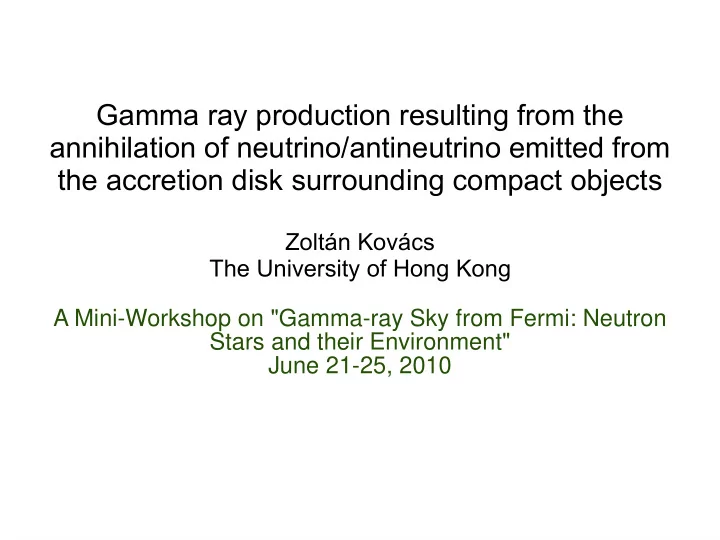

Gamma ray production resulting from the annihilation of neutrino/antineutrino emitted from the accretion disk surrounding compact objects Zoltán Kovács The University of Hong Kong A Mini-Workshop on "Gamma-ray Sky from Fermi: Neutron Stars and their Environment" June 21-25, 2010
Overview ● Toy model for (anti)neutrino annihilation in accreting systems (disk+central object) ● EOS of the central object (neutron/quark stars) ● Energy production close to the disk ● Energy production along the rotational axis ● Summary & outlook
Toy model for the energy source ● Rotating compact object EOS tables for neutron and quark matter ● Standard accretion disk model steady state model, geometrically thin and optically thick disk ● Neutrino source: only the disk, star is neglected ● electron/positron pair creation and E liberation via neutrino/antineutrino annihilation ● Considered along the equatorial plane and the rotational axis
EOS Neutron stars: DH (Douchin & Hanselm 2001), RMF soft/stiff (Kubis & Kutchera 1997), STOS T=0, 0.5, 1 MeV, (Shen, Toki, Oyamatsu & Sumiyoshi 1998), BBBAV14 & BBBParis (Baldo, Bombaci & Burgio 1997), APR (Akmal, Pandharipande & Ravenhall 1998) Quark stars: Q (Witten 1984, Chen et al. 1998), CFL Δ=150 MeV, … (Alford et al. 1999)
Energy Deposition Rate (EDR) The EDR per unit volume: Integrating in spherically symmetric geometry of the ST:
EDR along the disk Integrated over the 3-volume (Salmonson & Wilson 1999): Restricted into the equatorial plane: Compared with the Newtonian model:
EDR along the disk The radial distribution of EDR restricted into the equatorial plane (Kovács, Cheng & Harko 2009) Ω=5 10 3 s -1 M=2.8 M , Ω=5 10 3 s -1 M=1.8 M , ʘ ʘ RMF stiff & STOS: high EDR but small disk surface. Quark stars produce higher EDR.
EDR along the disk Dependence of the EDR on Ω for APR and Q type EOS (Kovács, Cheng & Harko 2009) M=1.8 M , Q M=1.8 M , APR ʘ ʘ The EDR is proportional to the rotational frequency.
EDR along the rotational axis Integrated over the 4-volume (Asano & Fukuyama 2001) but restricted along the axis of rotation: G describes the effects of the geometry on the EDR.
Dependence of the EDR on Ω: DH, APR, BBBAV14 & BBBParis M=1.8M
Dependence of the EDR on Ω: RMF stiff, STOS, Q & CFL M=1.8M
Summary & Outlook ● Studied simple models for energy production due to antineutrino/neutrino annihilation in accreting systems with rotating central objects ● Considered a broad variation of EOS for the central neutron and quark stars ● Presented the radial distribution of EDR along the equatorial plane and the rotational axis ● Considerable dependence on the EOS: quark stars produce higher rates ● Possible reconstruction of 3D maps for EDR
Recommend
More recommend